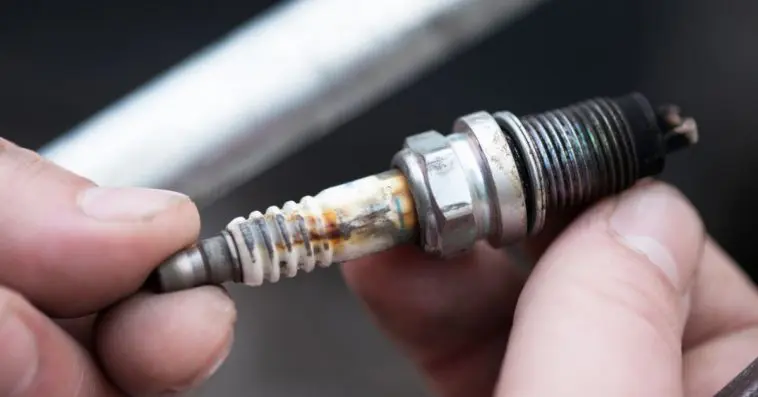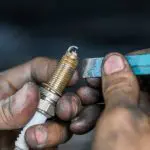Spark plugs, like any other component of the car, needs to be replaced after some time. This is because they get worn out with time and are unable to do their work.
Replacement will be necessary to improve the performance of the car engine.
Do you know how long do spark plugs can last? Spark plugs are designed to last for an average of 100,000 miles.
Some brands of spark plugs may even be useful for as much as 120,000 miles. This will be guaranteed if the condition of the engine is favorable.
Here are some of the factors that determine the lifespan of a spark plug:
- Electrode material
- Thread contact length
- Insulator nose length
- Projection of the electrode
When the spark plug is in good condition you not only realize a better performing engine but you will effect improved fuel consumption.
This is because if the spark plug is used for longer than needed it begins experiencing complications that would lead to fuel wastage.
TABLE OF CONTENTS
Spark Plugs Life For Popular Car Brands
You might realize that spark plug’s lifespan varies from one model of a car to the next. The following is a description of the lifespan of the spark plugs in the different models.
BMW
The latest models of the BMW have platinum-tipped spark plugs that are able to be used for as long as 100,000 miles.
Older models have high performance engines that wear out the spark plugs faster and they may only be able to be used for as long as 60,000 miles.
Mercedes Benz
The spark plugs on Mercedes Benz are designed with either platinum or iridium. They can last as long as 100,000 miles.
Mini Cooper
The spark plugs on Mini Coopers need to be changed after every 24,000 miles.
VW
The spark plugs for the VW are made with top performing materials such as platinum and iridium.
This gives them the capacity to last as long as 100,000 miles. They may even last more if provided with favorable conditions.
Honda CRV
The spark plugs on the Honda CRV will last for as much as 30,000 miles or for a period of two years.
This is not a long duration as you would get from other car models since they can get to at least 60,000 miles before they get damaged.
Nissan
The Nissan’s spark plugs can last for as long as 105,000 miles before you will need to replace them.
This is a good duration as most of the spark plugs in other car models would not even go beyond the 100,000-mile mark.
Toyota Camry
The spark plugs for the Toyota Camry can last for an average of 100,000 miles. This is a suitable duration as not many models of cars can have their spark plugs being as durable as in this case.
Toyota Prius
The lifespan of the spark plugs in the Toyota Prius is 120,000 miles. This is among the reliable and highly durable spark plugs that you can get in the market today.
Different Types Of Spark Plugs Lifespan
Spark plugs come in different brands which make the products using a variety of materials. Some types are designed to withstand harsh conditions and are able to last for much longer.
You can check on the lifespan of the variety types of spark plugs as discussed below:
Iridium Spark Plugs
For the iridium spark plugs, they are designed to be long lasting. As such they can last for as long as 100,000 miles or more.
This is provided that the vehicle engine does not expose it to oil and that the engine does not idle too much.
Denso Iridium Spark Plugs
This particular spark plug is designed with an iridium center electrode and a nickel one for the ground electrode.
The ground electrode wears out first making it have a superior lifespan than most types. It can last for as long as 60,000 or 80,000 miles.
Copper Spark Plugs
These are inferior types of spark plugs when compared to the platinum or iridium spark plugs.
As such they cannot much their lifespan. The copper types of spark plugs may only last 10,000 to 20,000 miles.
E3 Spark Plugs
The e3 spark plugs are long lasting products. They have a lifespan of 100,000 miles. This shows that this is a brand of spark plug that is highly durable and reliable.
Platinum Spark Plugs
Just like the iridium spark plugs. These are designed to have a longer lifespan than the cheap copper spark plugs. If subjected to a favorable condition, they may last as long as 100,000 miles.
NGK G Power Spark Plugs
The NGK G spark plugs have an iridium electrode at the center. A nickel construction is used for the ground electrode and this is what wears out first.
This type of spark plugs may not last for a longer time like most of the others. They have a lifespan of 40,000 to 50,000 miles.
NGK Laser Iridium Spark Plugs
The NGK laser iridium spark plugs have a platinum construction for the ground electrode and a center iridium electrode.
This type of spark plugs would last longer if they are used for the regular types of engines. They have a life expectancy that lies in the range of 80,000 and 100,000 miles.
How Do Spark Plugs Companies Make Their Spark Plugs Last Longer Than They Used To Be?
You might have realized that spark plugs would get damaged quite so often back in the days.
This made it necessary to get a replacement spark plug in less than every 10000 miles which might have been quite costly. The old versions of spark plugs also had to be cleaned and gapped often.
However, recent developments make it easy for a spark plug to be used in a vehicle for longer periods and this is made possible because of the following advancements in features:
And check the article on the best spark plugs that last long!
1. Elimination Of The Lead Fouling
When the authorities banned the use of harmful lead in the manufacture of spark plugs, the intention was to protect the humans as well as other living things in the environment.
As you might know, lead is a harmful substance that causes harm to any living thing in its environment. Similarly, lead was a major reason that staggered the performance of spark plugs.
The lead fouling made it necessary to clean the spark plugs often and also caused the spark plug to fail after being in use for a short while.
When it was removed, the spark plug lasted longer than before.
2. Reduction In Carbon Fouling
There were also regulations that made it necessary to remove tailpipe emissions.
These were the rich mixtures that were needed by the crude carbureted engines for them to ignite, work during the early stages and even speed up.
They carbon fouling necessitated the regular cleaning of the spark plugs ever so often.
Therefore, when they were done away with, the cleaning and replacement of spark plugs did not have to be done often.
3. Changes That Cancelled Oil Fouling
The introduction of synthetic oils that were seen to burn much cleaner than the previously used oils.
These enabled the plugs to work much easier than before because they were not contaminated with the oil as much as before.
Another change was the precision machining which improved the design of the engines in many types of cars.
The engines of these cars were created in such a way that not so much oil would go past the rings or even through the valve guides.
This reduced the dirtying of the spark plugs when exposed to too much oil.
4. Introduction Of The Computer Regulated Ignition
As a means to adhere to the regulations of the environment when it came to emissions, the manufacturers went the way of using computers to regulate the ignition of the vehicles.
This replaced the previous systems that were mainly designed with crude vacuum and centrifugal advance systems.
This improved the lifespan of the spark plugs as they were not as much susceptible to being burned as before due to being subjected to excessive ignition advance.
5. Changes In The Design
The new types of spark plugs are designed with much better inclusions that are effective for its top performance.
One change is when the manufacturers replaced the old points and coil system with a capacitive discharge which was later on followed with a fully coil-on-plug system.
This was effective as it improved the secondary voltage on the spark plug.
This change improved the reliability of the spark plug when it comes to firing even when it is slightly faulty.
For the spark plugs designed in this manner firing would not be a big issue even when their gaps are much wider than they need to be or even when they are slightly fouled from oil getting through the rings.
Other changes that improved the lifespan of spark plugs is that the copper electrodes have been replaced with much more effective and efficient alternatives.
The better performing spark plugs are manufactured with either platinum or iridium electrodes.
These are better replacements because unlike the copper electrode they are not much susceptible to erosion. They also do not make it necessary for you to frequently fill it and re-gap it.
Other slight changes included the extension of the tip which reduced the instances of oil fouling.
Another improvement that brought minor effects was the development of the composition of the insulator.
This made the spark plug work well when exposed to high temperatures and also improve its ability to resist breakages.
What Makes Spark Plugs Get Damaged Fast?
Spark plugs may develop complications when they are in use in the car for a significant time.
Since they are used all the time the car is running and accelerating, then they are bound to get damaged just like any other part of the car.
However, there are some factors that contribute to the spark plug getting damaged quite faster than they would in a normal case.
The factors are discussed below:
1. Oil Getting Through To The Combustion Chamber
This is the case mostly when yours is an old car that you have probably been using for a longer time.
For these types of vehicles, most of their components are worn out and are unable to do their work.
In this case, oil that is used in the lubrication of the car engine may get through to the combustion chamber.
This might be probably brought about by a faulty component that is responsible for blocking the oil from getting past it.
The combustion chamber is where the fuel and air mixture is ignited and this is where the spark plug is located.
When the oil gets to the spark plug, specifically the tip of the spark plug, it makes it oily and dirty. The buildup develops and the spark plug gets damaged and causes it to be unable to do its work.
2. Poorly Gapped Spark Plugs
The gaps on the spark plugs need to be maintained as per the specifications indicated by the brand manufacturer in the owner’s manual of the vehicle.
When you take the spark plug out to clean it or when you are installing a new spark plug, you need to verify the gap on the spark plug whenever there is a need to do so.
When the gap is either too wide or too narrow, complications might arise in the working of the spark plug.
The tip will be subjected to extra stress when the gap size is incorrect. What happens next is that it erodes and gets worn out much faster than before. This shortens the lifespan of the spark plugs.
Here’s how you can gap your spark plugs properly.
3. Carbon Buildup In The Car Engine
Carbon is a similar agent that causes the shortening of the lifespan of the spark plug like oil.
The buildup can be noticed as having sooty deposits that appear dry and dark. There are various issues that might cause the occurrence of carbon build up.
These include a crack that might be in the distributor case, fuel injectors that might not be clean, poor mixture of the air and fuel, a clogged air filter element and many others.
4. Subjection To Too Much Heat
When the tip of the spark plug gets overheated quite too often, then it might not last long. This might be the case when the engine’s timing is off and an issue such as pre-ignition happens.
What occurs next is that excess heat buildup in the combustion chamber. When the vehicle engine is running, the mixture of the fuel and air occurs first before the ignition part.
If the ignition occurs earlier than needed, then the spark plug is exposed to too much heat. This is referred to as pre-ignition.
Another cause of overheating of the spark plug is the failure of the cooling system to work as needed.
This causes the engine to get hotter most of the time and this will affect not only the performance of the spark plug but also the other components of the vehicle engine.
5. The Old Age Of The Vehicle
You might realize that the spark plugs on newer cars are able to last for fairly longer periods than in the older types of cars.
This is because the components of the engine in the older cars are probably worn out and unable to do their work.
This makes them have oil leakages to areas such as the combustion chamber and this affects the normal working of the spark plugs.
Moreover, the older models of cars are designed with inferior types of engines that would cause the spark plug to wear out faster than in the newer models.
The newer cars have advanced designs which are included to improve the lifespan of the spark plugs.
This is the reason why there are brands of spark plugs that may be used in models of cars for longer periods before they start experiencing complications while working.
As seen in the factors above, the condition of the vehicle’s engine determines the performance of the spark plugs.
If the vehicle is either too old or the engine is in poor condition, then it may not have the capacity to last for as long as it is expected to.
Conclusion
All in all, you can see that the lifespan of the spark plugs depends on the type of the spark plug you use, the car in which it is used in and the conditions it is subjected to while being used in the car.
You will need to be keen when it comes to your spark plug to guarantee its best performance.
You should know that the performance of the engine in your vehicle depends on the condition of the spark plug!
Sources:
1. Counterman – https://www.counterman.com/long-life-spark-plugs-can-last-100-000-miles-or-longer/
2. CARFAX Blog – https://www.carfax.com/blog/when-should-i-change-spark-plugs




